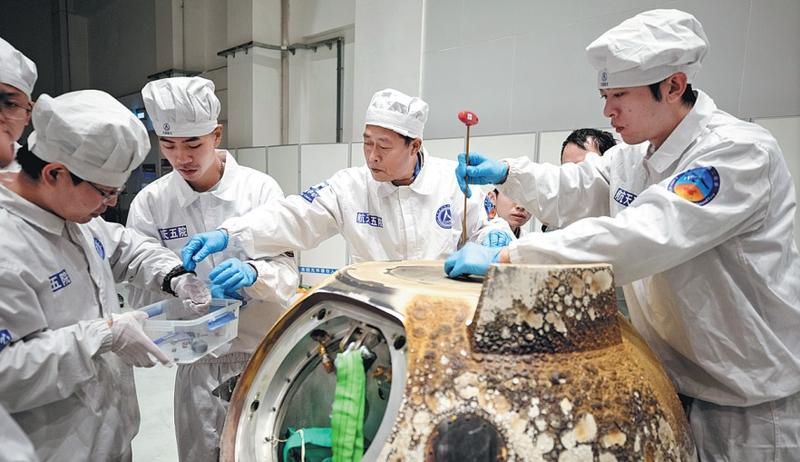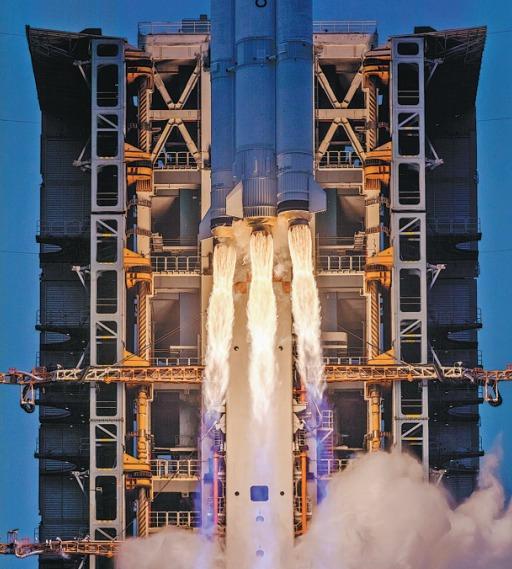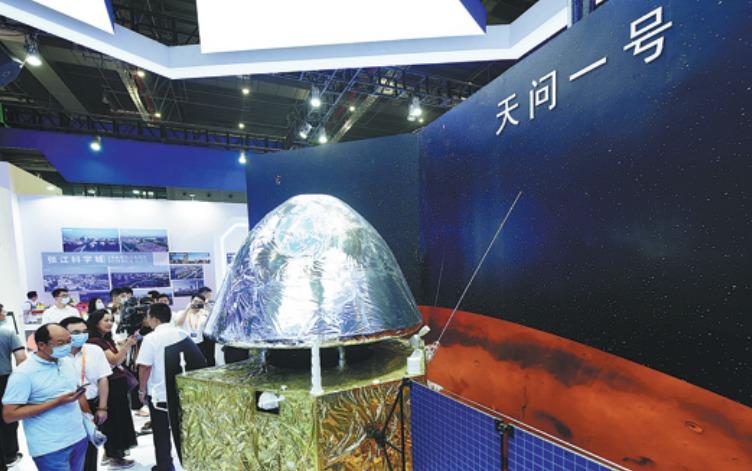 Scientists open the reentry capsule of the Chang'e 5 probe to extract the samples it brought back to Earth and weigh them at the Fifth Research Institute of the China Aerospace Science and Technology Corp on Dec 17. (JIN LIWANG / XINHUA)
Scientists open the reentry capsule of the Chang'e 5 probe to extract the samples it brought back to Earth and weigh them at the Fifth Research Institute of the China Aerospace Science and Technology Corp on Dec 17. (JIN LIWANG / XINHUA)
China's space industry has produced a remarkable scorecard this year: characterized by the nation's first independent Mars mission, the completion of a global navigation satellite network and a landmark adventure that retrieved rocks and soil from the moon.
Chang'e 5 was launched by a Long March 5 heavy-lift carrier rocket early on Nov 24 at the Wenchang Space Launch Center in South China's Hainan province
The most significant event in China's space field, and also one of the most notable space activities globally, this year-the Chang'e 5 robotic mission-returned 1,731 grams of lunar rock and soil to Earth, marking a historic accomplishment 44 years after the last lunar substances were retrieved.
The 23-day mission was China's first space journey to claim extraterrestrial samples, making it the third country to accomplish the feat after the United States and the former Soviet Union.
In a letter published after the samples arrived on Earth, President Xi Jinping extended warm congratulations and sincere greetings to all participants on behalf of the Communist Party of China Central Committee, the State Council and the Central Military Commission.
ALSO READ: Core module of China's 1st space station to be launched in 2021
Xi said that as China's most complicated space project, the Chang'e 5 mission completed the national space industry's first extraterrestrial sampling and return. It was the latest achievement by China's system, which is characterized by its ability to mobilize all available resources to overcome difficulties and achieve its goals, and also marks a major step forward for the country's space industry, he said.
The mission's results will contribute to mankind's deeper understanding of the moon's origins and the evolution of the solar system, he noted.
"Your extraordinary feats will be enshrined in the memories of our motherland and the people," Xi wrote, referring to those involved in the mission.
Chang'e 5, the nation's largest and most sophisticated lunar probe, was launched by a Long March 5 heavy-lift carrier rocket early on Nov 24 at the Wenchang Space Launch Center in South China's Hainan province.
It was the world's first mission to bring lunar samples back to Earth since 1976.
The 8.2-metric-ton spacecraft had four main components: an orbiter; lander; ascender; and reentry capsule. While in lunar orbit on Nov 30, the probe separated into two sections-the orbiter-reentry capsule combination and the lander-ascender combination.
Touchdown
On Dec 1, the lander-ascender touched down on the moon, becoming only the third spacecraft to reach the lunar surface since the mid-1970s, following Chang'e 3 and Chang'e 4.
Shortly after landing, the craft began drilling for samples 2 meters below the surface and using a mechanical arm to scoop up soil.
The collection operation finished after about 19 hours, on Dec 2, much earlier than expected. The samples were packed into a specially designed vacuum container inside the ascender to avoid contamination.
During the process, the lander unfurled the first free-standing Chinese national flag on the lunar surface, making China the second nation to place such an emblem on the moon after the US.
 The Long March 8 carrier rocket makes its maiden flight from the Wenchang Space Launch Center in Hainan province on Dec 22. (CHEN XIAO / CHINA DAILY)
The Long March 8 carrier rocket makes its maiden flight from the Wenchang Space Launch Center in Hainan province on Dec 22. (CHEN XIAO / CHINA DAILY)
On Dec 3, the ascender lifted itself into an elliptical lunar orbit to dock with the reentry capsule, thus marking the first time a Chinese spacecraft had blasted off from an extraterrestrial body. It linked up with the orbiter-reentry capsule combination on Dec 6 and transferred the lunar samples.
The ascender separated from the orbiter-reentry combination later that day and was deliberately crashed into the moon on Dec 8 to prevent it becoming space debris.
The combination made several preparatory maneuvers during lunar orbit and entered a moon-Earth transfer trajectory on Dec 13 to begin its flight back to Earth.
Early on Dec 17, the reentry capsule separated from the orbiter about 5,000 kilometers above the southern Atlantic Ocean and began its descent.
It touched down at a preset landing site in Siziwang Banner, Inner Mongolia autonomous region, at 1:59 am, ending a mission that had been closely followed by scientific communities and media around the globe.
The sealed samples were transferred to a specially designed laboratory at the Chinese Academy of Sciences and will later be distributed to researchers for analysis, experiments and tests.
"Research on lunar samples is one of the most important ways we can learn about the past, present and future of the moon, and also provides great help when scientists investigate the evolution of other members of our solar system," said Guo Hongfeng, a National Astronomical Observatories researcher.
Some of the samples will be put on display to boost scientific awareness, especially among the younger generation.
"This will greatly encourage people, especially young people, to study and explore the worlds beyond Earth," Xiao Long, a planetary geologist at the China University of Geosciences in Wuhan, Hubei province, told Nature magazine.
Officials at the China National Space Administration have welcomed cooperation from foreign scientists in researching the samples.
Interplanetary journeys
In addition to the moon, China's space authorities are looking farther into the solar system. They took the first step in the country's interplanetary voyage during the summer.
On July 23, Tianwen 1, China's first independent Mars mission, was launched from the Wenchang center by a Long March 5 rocket, opening the nation's planetary exploration program.
By the middle of this month, the 5-ton spacecraft-consisting of an orbiter and a landing capsule-was 100 million km from Earth, about 12 million km from Mars, and had traveled nearly 360 million km, according to the space administration.
If everything goes according to schedule, the probe will travel more than 470 million km before being captured by Mars' gravitational field in February, when it will be 193 million km from Earth.
Depending on the two planets' orbits, Mars is 55 million km to 400 million km from Earth.
After entering Mars' orbit, the spacecraft will circle the planet for two and a half months to examine the preset landing site before descending to release the capsule, which will fall gradually through the atmosphere.
The mission's goal is to deploy a rover in May on the southern part of Utopia Planitia-a vast plain within Utopia, the largest known impact basin in the solar system-to conduct scientific surveys.
Weighing about 240 kilograms, the rover, which has yet to be named, has six wheels and four solar panels, and can move at 200 meters an hour on Mars.
 Visitors examine a model of the landing capsule Tianwen 1 in Shanghai in September. (LONG WEI / CHINA DAILY)
Visitors examine a model of the landing capsule Tianwen 1 in Shanghai in September. (LONG WEI / CHINA DAILY)
It carries six scientific instruments including a multispectral camera, ground-penetrating radar and a meteorological sensor.
It is expected to work for about three months, and if the semi-autonomous machine functions well, it will become the fifth rover to be deployed on Mars, following four US predecessors.
If Tianwen 1 can fulfill its objectives-orbiting Mars for comprehensive observation, landing on the planet's surface and deploying a rover to conduct scientific operations-it will become the first Mars expedition to accomplish all three goals with one probe, according to Ye Peijian, a leading deep-space exploration scientist at the China Academy of Space Technology.
Tianwen 1 is the 46th exploration mission to the red planet since October 1960, when the former Soviet Union launched the first Mars-bound spacecraft. Only 17 of those missions were successful.
Global network
In late June, the final satellite to complete the third-generation network of the Beidou Navigation Satellite System was launched by a Long March 3B rocket at the Xichang Satellite Launch Center, Sichuan province, and placed in a geostationary orbit about 36,000 km above Earth.
After in-orbit tests, the satellite-the 59th in the Beidou family and 30th in the 3G series-started formal operations in late July, marking the start of Beidou's provision of full-scale global services.
Beidou is China's largest space-based system and one of four global navigation networks, along with the GPS of the US, Russia's GLONASS and the European Union's Galileo.
More than 300,000 scientists, engineers and technicians from more than 400 Chinese institutes, universities and enterprises have been involved in Beidou's development and construction.
Since 2000, 59 Beidou satellites, including the first four experimental models, have been launched from Xichang on 44 Long March 3 series rockets. Some have already been retired.
The system began providing positioning, navigation, timing and messaging services to civilian customers in China and other parts of the Asia-Pacific region in December 2012. At the end of 2018, it began providing basic global services.
There are now 30 3G Beidou satellites: 24 in medium-Earth orbit; three in inclined geosynchronous satellite orbit; and three in geostationary orbit.
Some 2G Beidou satellites are also in operation and offering regional services, according to the China Satellite Navigation Office.
Compared with 2G satellites, 3G models offer greater accuracy and stability, a clearer signal and more state-of-the-art technology such as intersatellite links, satellite-based augmentation and global emergency search capabilities.
In addition to space-based assets, Beidou has a ground-based network that includes dozens of stations, more than 200 subsystems and over 30,000 sets of equipment.
Expanding fleet
The Chinese space sector's most recent accomplishment came on Tuesday, when the newest carrier rocket-the Long March 8-made its maiden flight from Wenchang.
The 50-meter, medium-lift rocket transported five experimental satellites into a sun-synchronous orbit at an altitude of 512 km.
Designed and built by the China Academy of Launch Vehicle Technology, the rocket is tasked with meeting surging demand for launch services from commercial satellite companies at home and abroad.
Xiao Yun, the rocket's project manager, said the successful maiden flight was a new achievement in China's efforts to upgrade its medium-lift launch vehicle system, and will push forward the nation's efforts to become a world-class space power.
The rocket's services will also give a strong boost to the development and deployment of satellites operating in low-and medium-altitude orbits, he said.
The vehicle has two core stages and two side boosters. Its six engines are propelled by liquid oxygen, liquid hydrogen and kerosene.
With a liftoff weight of 356 tons, it is capable of sending 4.5-ton payloads into a sun-synchronous orbit 700 km above Earth, or satellites with a combined weight of 2.8 tons into a geostationary transfer orbit, the academy said.
Project managers have estimated that at least 10 Long March 8s will be used every year, given the robust demand from domestic and international satellite companies, while annual manufacturing capacity will soon reach 20.
 An attendee looks at a model of a Beidou Navigation Satellite at an expo in Shenyang, Liaoning province, in September. (HUANG JINKUN / CHINA DAILY)
An attendee looks at a model of a Beidou Navigation Satellite at an expo in Shenyang, Liaoning province, in September. (HUANG JINKUN / CHINA DAILY)
To improve the rocket's competitiveness, it is expected to eventually become the first reusable Long March model.
The designers intend to develop an integrated first stage for a reusable variant, consisting of a core booster and two side boosters.
Instead of breaking up and falling back to Earth like similar stages of previous Chinese rockets, the new core and side boosters will stay together and make powered landings on a recovery platform at sea.
About eight months ago, also in Wenchang, the Long March 5B heavy-lift carrier rocket undertook its maiden mission, transporting a prototype of China's new-generation manned spacecraft into a low-Earth orbit.
The rocket is 53.7 meters long, with a core-stage diameter of 5 meters, and has a liftoff weight of 849 tons. It is the most powerful Chinese rocket in terms of carrying capacity for low-Earth orbit.
The Long March 5B is central to the nation's space station program as it is the only Chinese launch vehicle capable of carrying large space station parts into orbit.
In the next two years, three Long March 5B flights will put major components of China's space station into orbit for assembly.
The multimodule station, Tiangong or Heavenly Palace, will have three sections-a core module and two space labs-with a combined weight of more than 90 tons.
It is expected to become fully operational before the end of 2022 and to operate for about 15 years.
Meanwhile, the new-generation manned spaceship has two main sections-the reentry and service modules. Tasked with serving the space station program, it employs world-class designs and technologies, and features great reliability and flexibility, multiple functions and reusability.
The craft is 8.8 meters long, has a diameter of 4.5 meters, and a liftoff weight of 21.6 tons.
READ MORE: China to launch 1st satellite for gravitational wave detection
The reentry module will house the crew and control the craft during spaceflight, while the service module will contain the power and propulsion systems.
Designers at the China Academy of Space Technology said that compared with the Shenzhou series, the country's operational crewed spacecraft family, the new model is capable of longer missions, housing more astronauts and cargo and operating in tougher environments.
Contact the writer at zhaolei@chinadaily.com.cn


